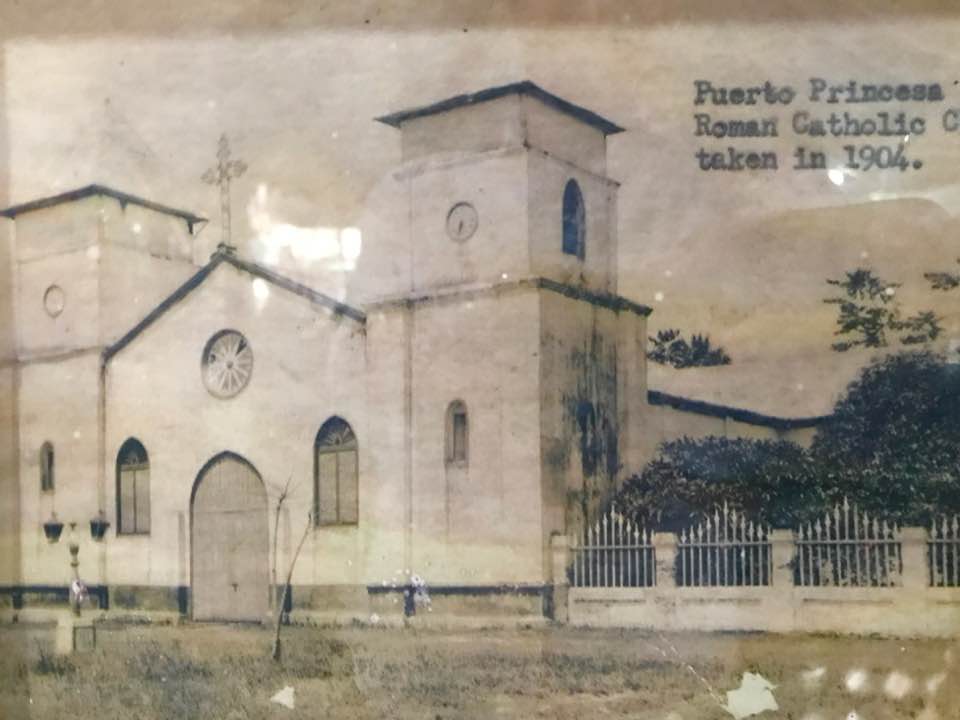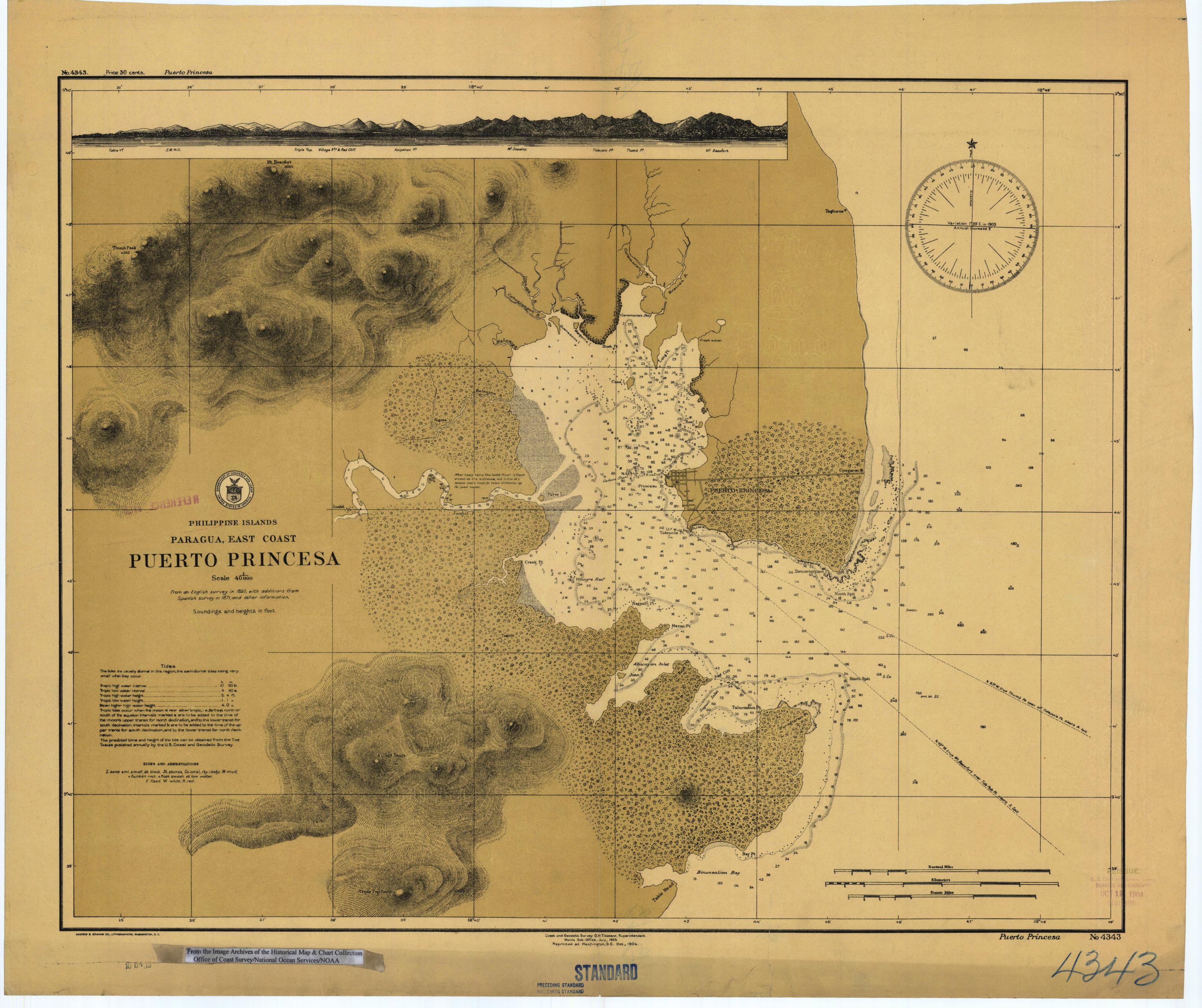|
Puerto Princesa Cathedral
The Puerto Princesa Cathedral ( fil, Katedral ng Puerto Princesa), also known as the Immaculate Conception Cathedral Parish ( fil, Parokyang Katedral ng Kalinis-linisang Paglilihi), is a Roman Catholic cathedral in the city of Puerto Princesa, Palawan in western Philippines. It is in the Neo-Gothic architectural tradition and is the mother church of the Apostolic Vicariate of Puerto Princesa which covers the municipalities of Palawan west of Puerto Princesa City. It is located at the border of Barangay Matiyaga Poblacion and Liwanag Poblacion, near the Port of Puerto Princesa. At 118° east longitude, it is the westernmost cathedral in the country. History The first mass in Puerto Princesa, initially a barrio, was held at the site of the present cathedral on March 10, 1872 by the Augustinian Recollect Fray Ezequiél Moreno (now a saint), six days after the Spanish expedition arrived in the area. Subsequently, Moreno established the town and its parish mission under the patronage o ... [...More Info...] [...Related Items...] OR: [Wikipedia] [Google] [Baidu] |
Puerto Princesa
Puerto Princesa, officially the City of Puerto Princesa (Cuyonon: ''Siyudad i'ang Puerto Princesa''; fil, Lungsod ng Puerto Princesa), is a 1st class highly urbanized city in the Mimaropa region of the Philippines. According to the 2020 census, it has a population of 307,079 people. It is a city located in the western Philippine province of Palawan, and is the westernmost city in the Philippines. Though the seat of government and capital for the province, the city itself is one of 38 independent cities within the Philippines not controlled by the province in which it is geographically located and is therefore an independent area located within Palawan. It is the least densely populated city in the Philippines with 110 inhabitants per square kilometre (280/square mile). In terms of land area, the city is the second largest geographically after Davao City with an area of . Puerto Princesa is the location of the Philippines' Western Command headquarters. Today, Puerto Princesa ... [...More Info...] [...Related Items...] OR: [Wikipedia] [Google] [Baidu] |
Barrio
''Barrio'' () is a Spanish language, Spanish word that means "Quarter (urban subdivision), quarter" or "neighborhood". In the modern Spanish language, it is generally defined as each area of a city, usually delimited by functional (e.g. residential, commercial, industrial, etc.), social, architectural or morphological features. In Spain, several Latin America, Latin American countries and the Philippines, the term may also be used to officially denote a division of a municipality. ''Barrio'' is an arabism (Classical Arabic ''barrī'': "wild" via Andalusian Arabic ''bárri'': "exterior"). Usage In Argentina and Uruguay, a ''barrio'' is a division of a municipality officially delineated by the local authority at a later time, and it sometimes keeps a distinct character from other areas (as in the Barrios and Communes of Buenos Aires, barrios of Buenos Aires even if they have been superseded by larger administrative divisions). The word does not have a special socioeconomic connotat ... [...More Info...] [...Related Items...] OR: [Wikipedia] [Google] [Baidu] |
Medieval Europe
In the history of Europe, the Middle Ages or medieval period lasted approximately from the late 5th to the late 15th centuries, similar to the post-classical period of global history. It began with the fall of the Western Roman Empire and transitioned into the Renaissance and the Age of Discovery. The Middle Ages is the middle period of the three traditional divisions of Western history: classical antiquity, the medieval period, and the modern period. The medieval period is itself subdivided into the Early, High, and Late Middle Ages. Population decline, counterurbanisation, the collapse of centralized authority, invasions, and mass migrations of tribes, which had begun in late antiquity, continued into the Early Middle Ages. The large-scale movements of the Migration Period, including various Germanic peoples, formed new kingdoms in what remained of the Western Roman Empire. In the 7th century, North Africa and the Middle East—most recently part of the Eastern Rom ... [...More Info...] [...Related Items...] OR: [Wikipedia] [Google] [Baidu] |
Empire Of Japan
The also known as the Japanese Empire or Imperial Japan, was a historical nation-state and great power that existed from the Meiji Restoration in 1868 until the enactment of the post-World War II 1947 constitution and subsequent formation of modern Japan. It encompassed the Japanese archipelago and several colonies, protectorates, mandates, and other territories. Under the slogans of and following the Boshin War and restoration of power to the Emperor from the Shogun, Japan underwent a period of industrialization and militarization, the Meiji Restoration, which is often regarded as the fastest modernisation of any country to date. All of these aspects contributed to Japan's emergence as a great power and the establishment of a colonial empire following the First Sino-Japanese War, the Boxer Rebellion, the Russo-Japanese War, and World War I. Economic and political turmoil in the 1920s, including the Great Depression, led to the rise of militarism, nationa ... [...More Info...] [...Related Items...] OR: [Wikipedia] [Google] [Baidu] |
Americans
Americans are the Citizenship of the United States, citizens and United States nationality law, nationals of the United States, United States of America.; ; Although direct citizens and nationals make up the majority of Americans, many Multiple citizenship, dual citizens, expatriates, and green card, permanent residents could also legally claim American nationality. The United States is home to race and ethnicity in the United States, people of many racial and ethnic origins; consequently, culture of the United States, American culture and Law of the United States, law do not equate nationality with Race (human categorization), race or Ethnic group, ethnicity, but with citizenship and an Oath of Allegiance (United States), oath of permanent allegiance. Overview The majority of Americans or their ancestors Immigration to the United States, immigrated to the United States or are descended from people who were Trans Atlantic Slave Trade, brought as Slavery in the United States ... [...More Info...] [...Related Items...] OR: [Wikipedia] [Google] [Baidu] |
World War II
World War II or the Second World War, often abbreviated as WWII or WW2, was a world war that lasted from 1939 to 1945. It involved the vast majority of the world's countries—including all of the great powers—forming two opposing military alliances: the Allies and the Axis powers. World War II was a total war that directly involved more than 100 million personnel from more than 30 countries. The major participants in the war threw their entire economic, industrial, and scientific capabilities behind the war effort, blurring the distinction between civilian and military resources. Aircraft played a major role in the conflict, enabling the strategic bombing of population centres and deploying the only two nuclear weapons ever used in war. World War II was by far the deadliest conflict in human history; it resulted in 70 to 85 million fatalities, mostly among civilians. Tens of millions died due to genocides (including the Holocaust), starvation, ma ... [...More Info...] [...Related Items...] OR: [Wikipedia] [Google] [Baidu] |
Puerto Princesa Cathedral 1904
{{disambiguation, geo ...
Puerto, a Spanish word meaning ''seaport'', may refer to: Places *El Puerto de Santa María, Andalusia, Spain *Puerto, a seaport town in Cagayan de Oro City, Philippines *Puerto Colombia, Colombia *Puerto Cumarebo, Venezuela *Puerto Galera, Oriental Mindoro, Philippines * Puerto La Cruz, Venezuela *Puerto Píritu, Venezuela *Puerto Princesa, Palawan, Philippines *Puerto Rico, an unincorporated territory of the United States *Puerto Vallarta, Mexico Others * ''Puerto Rico'' (board game) *Operación Puerto doping case See also * * Puerta (other) Puerta refers to the old original gates of the Walled City of Intramuros in Manila. Puerta may also refer to: People *Antonio Puerta, Spanish footballer *Alonso José Puerta, Spanish politician *Lina Puerta, American artist *Mariano Puerta, Argent ... [...More Info...] [...Related Items...] OR: [Wikipedia] [Google] [Baidu] |
Virgin Mary
Mary; arc, ܡܪܝܡ, translit=Mariam; ar, مريم, translit=Maryam; grc, Μαρία, translit=María; la, Maria; cop, Ⲙⲁⲣⲓⲁ, translit=Maria was a first-century Jewish woman of Nazareth, the wife of Joseph and the mother of Jesus. She is a central figure of Christianity, venerated under various titles such as virgin or queen, many of them mentioned in the Litany of Loreto. The Eastern and Oriental Orthodox, Church of the East, Catholic, Anglican, and Lutheran churches believe that Mary, as mother of Jesus, is the Mother of God. Other Protestant views on Mary vary, with some holding her to have considerably lesser status. The New Testament of the Bible provides the earliest documented references to Mary by name, mainly in the canonical Gospels. She is described as a young virgin who was chosen by God to conceive Jesus through the Holy Spirit. After giving birth to Jesus in Bethlehem, she raised him in the city of Nazareth in Galilee, and was in Jerusal ... [...More Info...] [...Related Items...] OR: [Wikipedia] [Google] [Baidu] |
Captaincy General Of The Philippines
The Captaincy General of the Philippines ( es, Capitanía General de Filipinas ; tl, Kapitaniya Heneral ng Pilipinas) was an administrative district of the Spanish Empire in Southeast Asia governed by a Governor-General of the Philippines, governor-general as a dependency of the New Spain, Viceroyalty of New Spain based in Mexico City until Mexican independence when it was transferred directly to Madrid. The Captaincy General encompassed the Spanish East Indies, which included among others the Philippine Islands, the Mariana Islands, and the Caroline Islands. It was founded in 1565 with the first permanent Spanish forts. For centuries, all the administrative, political and economic aspects of the Captaincy General were administered in Mexico City by the Viceroyalty of New Spain for the Spanish Crown. However, in 1821, following the Declaration of Independence of the Mexican Empire, independence of the Mexican empire, all control was transferred to Madrid. It was succeeded by th ... [...More Info...] [...Related Items...] OR: [Wikipedia] [Google] [Baidu] |
Saint
In religious belief, a saint is a person who is recognized as having an exceptional degree of Q-D-Š, holiness, likeness, or closeness to God. However, the use of the term ''saint'' depends on the context and Christian denomination, denomination. In Catholic Church, Catholic, Eastern Orthodox Church, Eastern Orthodox, Anglican Communion, Anglican, Oriental Orthodox, and Lutheranism, Lutheran doctrine, all of their faithful deceased in Heaven are considered to be saints, but some are considered worthy of greater honor or emulation. Official ecclesiastical recognition, and consequently a public cult of veneration, is conferred on some denominational saints through the process of canonization in the Catholic Church or glorification in the Eastern Orthodox Church after their approval. While the English word ''saint'' originated in Christianity, History of religion, historians of religion tend to use the appellation "in a more general way to refer to the state of special holiness t ... [...More Info...] [...Related Items...] OR: [Wikipedia] [Google] [Baidu] |
Ezequiél Moreno Y Díaz
Ezequiél Moreno y Díaz, OAR was a Spanish Catholic friar in the Order of Augustinian Recollects and now venerated as a saint. He was born on April 9, 1848, in Alfaro, La Rioja, Spain and later served as a missionary to the Philippines. He also became the Bishop of Pinara and later of Pasto, in Colombia. His nephew Julián Moreno is also venerated as a Blessed because of his martyrdom in Motril. Moreno is popularly invoked as the patron of cancer patients. Early life and entry to the Order of Augustinian Recollects Born in the city of Alfaro, La Rioja, Spain to Félix Moreno and María Josefa Díaz, he was the third of six children along with Eustaquio, Juana, Valentina and Benigna. His fourth sister, named María de las Candelas, died. Moreno first wore the habit of the Recoletos in Monteagudo, Navarra, Spain on September 21, 1864. Later, he made his solemn vow in Marcialla (also in Navarra) on September 22, 1868. Philippine missions Arrival and ordination in Manila The ... [...More Info...] [...Related Items...] OR: [Wikipedia] [Google] [Baidu] |


.jpg)





